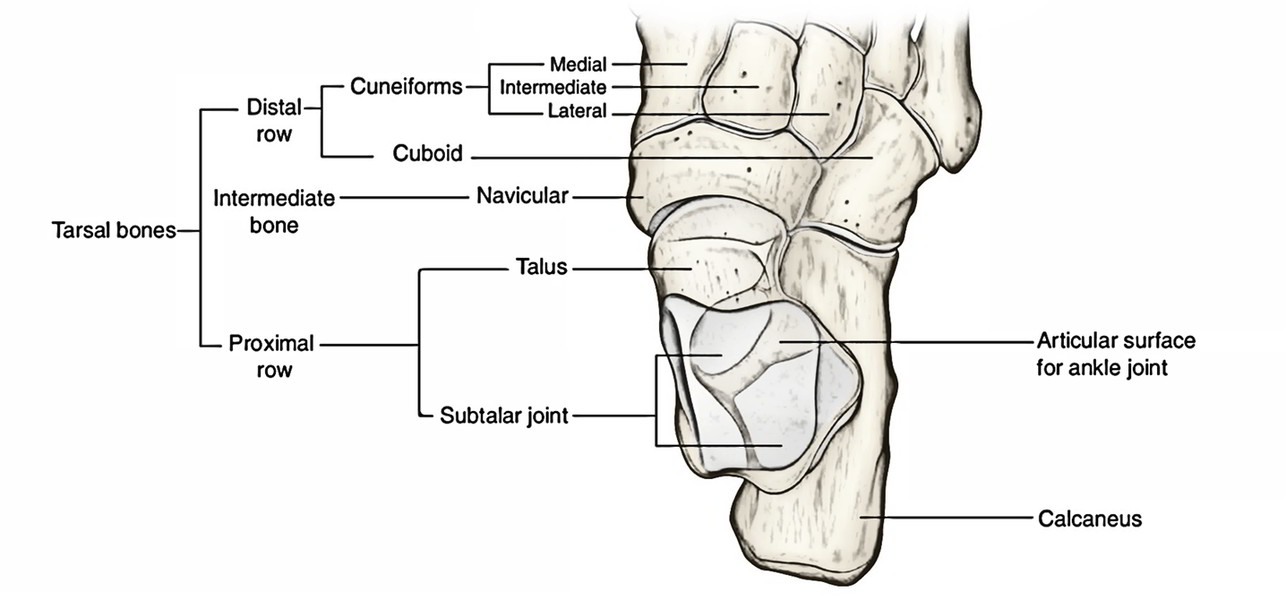 Common Features
Common Features
- There are three cuneiform bones, medial, intermediate and lateral. The medial cuneiform is the largest and the intermediate cuneiform, the smallest.
- As their name suggests, these are wedge-shaped bones. In the medial cuneiform, the edge of the wedge forms the dorsal surface. In the intermediate and lateral cuneiforms, the thin edge of the wedge forms the plantar surface.
- The anterior parts of the medial and lateral cuneiforms projects further forwards than the intermediate cuneiform. This forms a deep recess for the base of the second metatarsal bone.
Medial Cuneiform
Side Determination
- The thin edge forms the dorsal surface.
- The proximal and distal surfaces are fully articular. The distal surface is much larger than the proximal. The distal surface bears a large kidneyshaped facet for the base of the first metatarsal bone. The hilum of this facet is directed laterally.
Features
- The dorsal surface is formed by the rough edge of the wedge.
- The plantar surface is formed by the base of the wedge.
- The distal surface has a large kidney-shaped facet for the base of the first metatarsal bone, with its hilum directed laterally.
- The proximal surface is a pyriform facet for the navicular.
- The medial surface is rough and subcutaneous.
- The lateral surface is marked by an inverted L- shaped facet along the posterior and superior margins for the intermediate cuneiform bone. The anterosuperior part of the facet is separated by a vertical ridge. This part is for the base of the second metatarsal bone. The anteroinferior part of the lateral surface is roughened.
Attachments
- The greater part of the tibialis anterior is inserted into an impression on the anteroinferior angle of the medial surface.
- The plantar surface receives a slip from the tibialis posterior.
- A part of the peroneus longus is inserted into the rough anteroinferior part of the lateral surface.
Intermediate Cuneiform
Side Determination
- The dorsal surface is formed by the base of the wedge.
- The medial surface bears an inverted L-shaped facet along its posterior and superior margins, for articulation with a facet on the medial cuneiform.
Additional Features
- The proximal and distal surfaces bear triangular articular facets.
- The lateral surface is marked by a vertical facet along its posterior margin. This facet is for the lateral cuneiform bone. It is indented in the middle.
- The plantar surface is formed by the edge of the wedge.
Attachments
- The plantar surface receives a slip from the tibialis posterior.
Lateral Cuneiform
Side Determination
- The dorsal surface is formed by the base of the wedge.
- The distal surface is completely covered by a triangular articular facet for the third metatarsal bone.
- The medial surface is marked along its posterior margin by a vertical strip indented in the middle, for articulation with the intermediate cuneiform bone. Along the anterior margin of the surface there is a narrow strip often divided into two small facets. These are for the base of the second metatarsal bone.
Additional Features
The proximal surface is rough in its lower one- third, and has a triangular facet in its upper two- thirds for the navicular bone.
The lateral surface is marked in its postero- superior part by a triangular or oval facet for the cuboid. At the anteroinferior angle, a small facet may be present for the fourth metatarsal bone.
The plantar surface is formed by the edge of the wedge.
Attachments
The plantar surface receives a slip from the tibialis posterior, and may give origin to the flexor hallucis brevis.
Ossification
Each cuneiform bone ossifies from one centre, which appears during the first year in the lateral cuneiform during the second year in the medial cuneiform, and during the third year in the intermediate cuneiform bone.
 Common Features
Common Features
 (54 votes, average: 4.78 out of 5)
(54 votes, average: 4.78 out of 5)